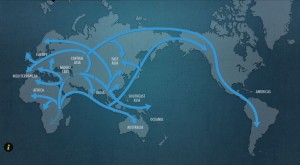Migration as old as humanity itself
 When humans first ventured out of Africa some 60,000 years ago, they left genetic footprints still visible today.
When humans first ventured out of Africa some 60,000 years ago, they left genetic footprints still visible today.
Now, scientists working on the global human genome project have mapped the appearance and frequency of genetic markers in modern peoples to create a picture of when, where and how ancient humans colonised the globe.
These great migrations eventually led the descendants of a small group of Africans to occupy the furthest reaches of the Earth.
As migration from Africa, and other places, becomes a contentious issue around the world it might bear remembering that, as this project shows, migration is as old as humanity itself. Africa is where humanity first evolved, and where we have spent the majority of our time on Earth.
The earliest fossils of recognisably modern Homo sapiens appear in the fossil record at Omo Kibish in Ethiopia, around 200,000 years ago.
According to the genetic and palaeontological data, humans began to move out of Africa between 60,000 and 70,000 years ago. One theory about what sparked this – something that also resonates today – is that it has something to do with major climatic shifts; perhaps a sudden cooling in the Earth’s climate driven by the onset of one of the worst parts of the last Ice Age.
Genetic evidence points to a sharp reduction in population size around this time with the human dropping to fewer than 10,000.
When the climate started to warm again, about 70,000 years ago, humanity came back from near-extinction. Populations increased and some ventured beyond Africa.
The earliest people to colonise the Eurasian landmass are thought to have crossed the Bab-al- Mandab Strait separating present-day Yemen from Djibouti. These early beachcombers expanded rapidly along the coast to India, and reached Southeast Asia and Australia 50,000 years ago.
A little later, a second group appears to have set out on an inland trek, leaving behind the certainties of life in the tropics to head out into the Middle East and southern Central Asia. From there, groups of humans were poised to settle the northern latitudes of Asia, Europe, and beyond. Around 20,000 years ago, at a time when great ice sheets covering the far north had literally sucked up much of the Earth’s moisture dropping sea levels by more than 300, a land bridge was exposed connecting Asia to the Americas.
Across this bridge a group of hunters made the final great journey of human settlement of the globe. Within 6,000 years they journeyed all the way to the tip of South America.
Highlights
Out of Africa
Researchers have identified the Bab-el-Mandeb Strait on the Red Sea as the most likely departure point for the first human exodus from Africa. This narrow stretch of water between the Horn of Africa and the Arabian Peninsula offered the shortest route to new continents. The strait would actually have been even less of a stretch than it is today (18 kms), because when Homo sapiens made the crossing some 60,000 to 70,000 years ago, sea levels were 230 feet lower due to the onset of the ice age.
The seeds of civilisation
The Fertile Crescent area of today’s Middle East is thought to be one of the key locations in the development of farming and agriculture. Taking root around 12,000 years ago, agriculture triggered such a change in society and the way people lived that its development has been dubbed the “Neolithic Revolution.” Traditional hunter-gatherer lifestyles followed by humans since their evolution were swept aside in favor of permanent settlements and a reliable food supply. Out of agriculture, cities and civilisations grew.
A momentous crossing shrouded in mystery
About 50,000 years ago, a small band of humans landed in northern Australia, arriving on a primitive boat or raft. It is likely that the journey was planned because enough men and women arrived to set up a new population here. The group ventured inland where they found giant mammals, birds, and reptiles ripe for hunting – and no competition from other humans. The ocean crossing from Asia to Australia is one of humanity’s great early achievements, but it’s a mystery exactly and why these humans made the journey.
The beginnings of art
Art is seen as a key signpost to humans’ evolutionary past and the development of civilisation. Cave paintings in Europe, such as the famous animal scenes at Lascaux in France, marked the beginnings of imagined art. Intricate rock art in Australia’s Northern Territory date back at least 30,000.













